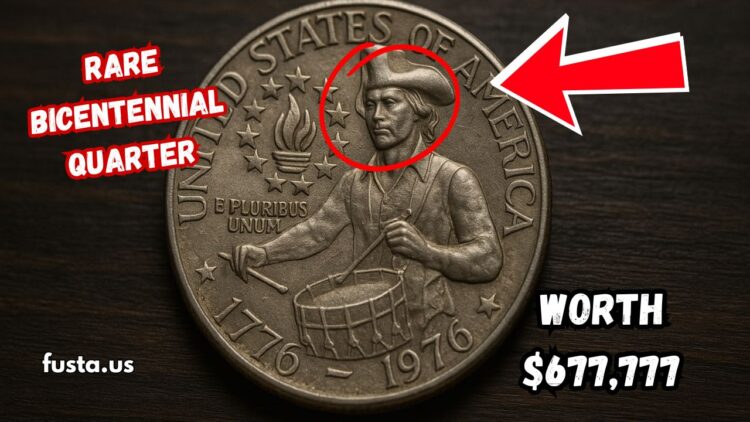Have you ever wondered if the spare change in your pocket could be worth a fortune? Believe it or not, one ordinary-looking Bicentennial quarter from 1976 shocked collectors when it sold for $677,777 at an auction. While most of these coins are worth just 25 cents, a few rare versions can be worth thousands—or even hundreds of thousands—of dollars.
In this article, we’ll explore the history of the Bicentennial quarter, what makes some of them so valuable, and how you can check if you might have one of these rare coins sitting in your wallet, piggy bank, or coin jar.
What is the Bicentennial Quarter?
The Bicentennial quarter was released to celebrate 200 years of American independence. These coins were minted in 1975 and 1976. Unlike regular quarters that feature a bald eagle on the back, this coin has a special design:
- A Colonial drummer boy holding a drum
- A torch surrounded by 13 stars representing the first 13 U.S. colonies
- A dual date: 1776–1976, marking the bicentennial celebration
Because millions of these coins were produced, most are still common. However, certain versions—like proof coins, silver coins, and coins with minting errors—are very rare and can be worth a fortune.
Why Did One Sell for $677,777?
Not every Bicentennial quarter is worth more than face value. But the one that sold for $677,777 was special because:
- It was in perfect mint condition (graded MS-67+ or higher).
- It had a rare minting error, making it unique.
- It was possibly made from 40% silver, not the usual copper-nickel mix.
Collectors pay high prices for coins that are both rare and flawless. A coin in perfect condition from the 1970s, with special material or a mint error, is a once-in-a-lifetime find.
Valuable Bicentennial Quarters
| Feature | Details |
|---|---|
| Year | 1976 (minted in 1975 & 1976) |
| Special Design | Drummer boy with torch & 13 stars |
| Dual Date | 1776–1976 |
| Possible Silver Version | 40% silver (collector/proof sets) |
| High Value Factors | Mint errors, MS-67+ grade, silver content |
| Auction Record | $677,777 |
What Makes a Quarter Valuable?
If you want to know whether your Bicentennial quarter is valuable, here are the key things to look for:
1. Material
Some quarters were struck in 40% silver, especially in collector sets. Silver coins weigh slightly more and sound different when dropped compared to copper-nickel ones.
2. Mint Mark
Check below the date for a mint mark:
- S = San Francisco (often silver or proof coins)
- D = Denver
- No Mark = Philadelphia
San Francisco coins, especially proof and silver ones, are more likely to be rare.
3. Condition
A coin that looks brand new and hasn’t been used is called Mint State (MS). Coins graded MS-65 and higher can sell for hundreds or even thousands of dollars.
4. Minting Errors
Coins with mistakes are highly collectible. Look for:
- Double stamping
- Off-center images
- Odd shapes or missing details
How Can You Check Your Quarter?
You don’t need to be a professional to check your coin. Just follow these steps:
- Look at the design – It should have the drummer boy and 1776–1976 date.
- Check the mint mark – An “S” could mean it’s silver.
- Weigh the coin – A regular coin weighs 5.67 grams; silver versions weigh slightly more (around 5.75 g).
- Use a magnifying glass – Look for errors or unusual features.
- Don’t clean it – Cleaning can damage the surface and reduce the value.
If you think your coin might be valuable, take it to a coin shop or send it to a professional grading service like PCGS or NGC.
Could This Really Be in Your Pocket?
It may sound like a dream, but rare coins often turn up in everyday life. People have found valuable Bicentennial quarters in:
- Old coin jars
- Forgotten piggy banks
- Loose change at the store
- Family collections passed down for generations
So next time you get quarters as change, don’t ignore them. You could be holding a piece of history worth more than a new car.
Most Bicentennial quarters are only worth 25 cents, but rare ones with errors, silver content, or perfect grading can sell for thousands. In some cases, like the $677,777 auction coin, they can reach unbelievable prices.
The best part? You don’t need to be a professional collector to find one. All it takes is careful checking of your change and knowing what to look for. So keep your eyes open—you might already be carrying a small fortune in your pocket.
FAQs
How can I tell if my Bicentennial quarter is silver?
Check for the “S” mint mark and weigh the coin. Silver versions weigh slightly more (around 5.75 g) and don’t have a copper-colored edge.
Are all Bicentennial quarters valuable?
No. Most are just worth 25 cents, but special versions with mint errors, silver content, or high Mint State grades can be worth thousands.
What should I do if I think I found a valuable coin?
Keep it safe, don’t clean it, and take it to a professional grading service or coin shop for evaluation.
